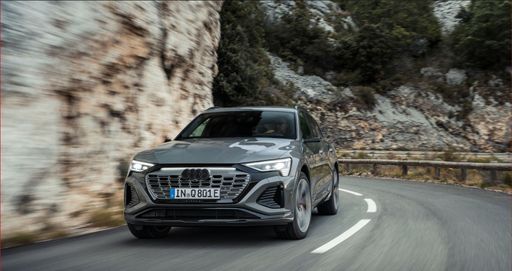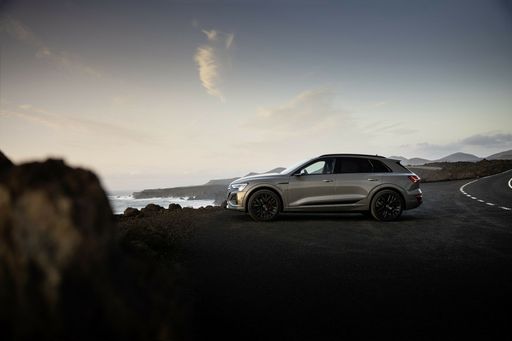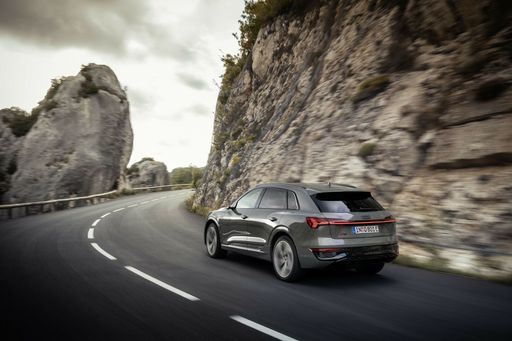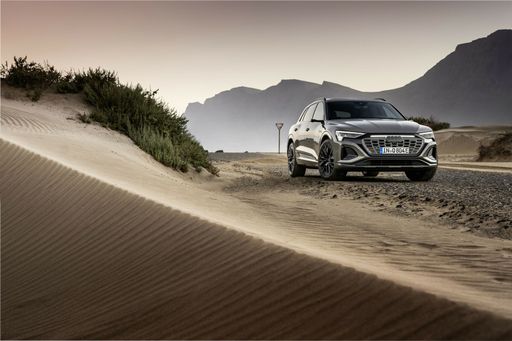Audi Q8 e-tron vs Volvo ES90 – Which one offers the better deal?
Everyday use, family trips or long-distance drives – here’s where the differences show.
Discover whether Audi Q8 e-tron or Volvo ES90 fits your lifestyle better.
Here’s where it gets real: The technical differences in detail
Costs and Efficiency: Price and efficiency are often the first things buyers look at. Here it becomes clear which model has the long-term edge – whether at the pump, the plug, or in purchase price.
Volvo ES90 has a slight advantage in terms of price – it starts at 61700 £, while the Audi Q8 e-tron costs 65100 £. That’s a price difference of around 3352 £.
In terms of energy consumption, the advantage goes to the Volvo ES90: with 15.90 kWh per 100 km, it’s clearly perceptible more efficient than the Audi Q8 e-tron with 19.70 kWh. That’s a difference of about 3.80 kWh.
As for range, the Volvo ES90 performs somewhat better – achieving up to 700 km, about 105 km more than the Audi Q8 e-tron.
Engine and Performance: Power, torque and acceleration are the classic benchmarks for car enthusiasts – and here, some clear differences start to show.
When it comes to engine power, the Volvo ES90 has a distinct edge – offering 680 HP compared to 503 HP. That’s roughly 177 HP more horsepower.
In acceleration from 0 to 100 km/h, the Volvo ES90 is a bit quicker – completing the sprint in 4 s, while the Audi Q8 e-tron takes 4.50 s. That’s about 0.50 s faster.
In terms of top speed, the Audi Q8 e-tron performs to a small extent better – reaching 210 km/h, while the Volvo ES90 tops out at 180 km/h. The difference is around 30 km/h.
There’s also a difference in torque: the Audi Q8 e-tron pulls slightly stronger with 973 Nm compared to 870 Nm. That’s about 103 Nm difference.
Space and Everyday Use: Whether family car or daily driver – which one offers more room, flexibility and comfort?
Both vehicles offer seating for 5 people.
In curb weight, the Volvo ES90 is slight lighter – 2410 kg compared to 2585 kg. The difference is around 175 kg.
In terms of boot space, the Audi Q8 e-tron offers noticeable more room – 569 L compared to 424 L. That’s a difference of about 145 L.
In maximum load capacity, the Audi Q8 e-tron performs to a small extent better – up to 1637 L, which is about 210 L more than the Volvo ES90.
When it comes to payload, Audi Q8 e-tron somewhat takes the win – 595 kg compared to 500 kg. That’s a difference of about 95 kg.
All in all, the Volvo ES90 shows itself to be wins by a narrow margin and secures the title of DriveDuel Champion.
It impresses with the more balanced overall package and proves to be the more versatile companion for everyday use.
Audi Q8 e-tron
The Q8 e-tron stands out with its striking design and luxurious interior, offering a seamless blend of sophistication and cutting-edge technology. This all-electric SUV not only promises an exhilarating driving experience but also emphasizes sustainability without compromising on performance. With its spacious cabin and advanced infotainment features, the Q8 e-tron is sure to appeal to those seeking both comfort and efficiency in their next vehicle.
details @ Audi
@ Audi
 @ Audi
@ Audi
 @ Audi
@ Audi
 @ Audi
@ Audi
 @ Audi
@ Audi
 @ Audi
@ Audi
 @ Audi
@ Audi
Volvo ES90
The Volvo ES90 stands out as a luxury sedan, embodying Scandinavian elegance combined with innovative technology. Its sleek design is complemented by a plush interior that emphasizes comfort and safety, aligning with Volvo's renowned reputation. With advanced features and a focus on sustainability, the ES90 is a testament to the brand's commitment to responsible luxury.
details

|
|
|
|
|
Costs and Consumption |
|
|---|---|
|
Price
65100 - 102800 £
|
Price
61700 - 81000 £
|
|
Consumption L/100km
-
|
Consumption L/100km
-
|
|
Consumption kWh/100km
19.7 - 26.3 kWh
|
Consumption kWh/100km
15.9 - 17.1 kWh
|
|
Electric Range
456 - 595 km
|
Electric Range
651 - 700 km
|
|
Battery Capacity
89 - 106 kWh
|
Battery Capacity
88 - 102 kWh
|
|
co2
0 g/km
|
co2
0 g/km
|
|
Fuel tank capacity
-
|
Fuel tank capacity
-
|
Dimensions and Body |
|
|---|---|
|
Body Type
SUV
|
Body Type
Hatchback
|
|
Seats
5
|
Seats
5
|
|
Doors
5
|
Doors
5
|
|
Curb weight
2585 - 2725 kg
|
Curb weight
2410 - 2610 kg
|
|
Trunk capacity
528 - 569 L
|
Trunk capacity
424 L
|
|
Length
4915 mm
|
Length
5000 mm
|
|
Width
1937 - 1994 mm
|
Width
1942 mm
|
|
Height
1617 - 1683 mm
|
Height
1546 mm
|
|
Max trunk capacity
1567 - 1637 L
|
Max trunk capacity
1427 L
|
|
Payload
515 - 595 kg
|
Payload
490 - 500 kg
|
Engine and Performance |
|
|---|---|
|
Engine Type
Electric
|
Engine Type
Electric
|
|
Transmission
Automatic
|
Transmission
Automatic
|
|
Transmission Detail
Reduction Gearbox
|
Transmission Detail
Reduction Gearbox
|
|
Drive Type
All-Wheel Drive
|
Drive Type
Rear-Wheel Drive, All-Wheel Drive
|
|
Power HP
340 - 503 HP
|
Power HP
333 - 680 HP
|
|
Acceleration 0-100km/h
4.5 - 6 s
|
Acceleration 0-100km/h
4 - 6.6 s
|
|
Max Speed
200 - 210 km/h
|
Max Speed
180 km/h
|
|
Torque
664 - 973 Nm
|
Torque
480 - 870 Nm
|
|
Number of Cylinders
-
|
Number of Cylinders
-
|
|
Power kW
250 - 370 kW
|
Power kW
245 - 500 kW
|
|
Engine capacity
-
|
Engine capacity
-
|
General |
|
|---|---|
|
Model Year
2023 - 2024
|
Model Year
2025
|
|
CO2 Efficiency Class
A
|
CO2 Efficiency Class
A
|
|
Brand
Audi
|
Brand
Volvo
|
What drive types are available for the Audi Q8 e-tron?
The Audi Q8 e-tron is offered with All-Wheel Drive.
The prices and data displayed are estimates based on German list prices and may vary by country. This information is not legally binding.
